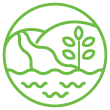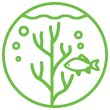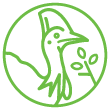Invasive non-native terrestrial flora species
Key Finding
Invasive non-native flora species degrade natural vegetation and impact on biodiversity generally.
Invasive non-native flora species—weeds—are widespread across Queensland and have the potential to degrade natural vegetation and impact on biodiversity.
For example, rubber vine could completely destroy all deciduous vine thickets in northern Queensland, leading to the loss of entire unique ecosystems, and extinction of many plant and animal species. High biomass grasses can increase fire frequency and intensity, causing irreversible changes to vegetation structure.
Weed management practices need to consider environmental impacts. For example, tillage can result in soil erosion and subsequent pollution of river systems. Inappropriate use of fire in weed management programs may result in ecosystem modification.
New pest plant introductions and outbreaks continue to occur throughout Queensland via pathways such unintentional transportation on equipment, cargo, fodder, animals or other transport. Occasionally new pest plants result from an intentional introduction of a species by land managers. Hudson pear is one such emerging threat in Queensland. It has the potential to destroy grazing land and prevent outdoor activity. Although currently rare in Queensland, Hudson pear is considered a high-risk invasive pest, highlighting the importance of preventing further spread.
More information:
Relevant Sustainable Development Goals’ targets
Distribution of Hudson pear (Cylindropuntia rosea) between 2013–2014
Distribution of rubber vine (Cryptostegia grandiflora) in 2018
Source: Queensland Pest distribution survey from 2013-2014. Supplemental information from DAF and from Atlas of Living Australia / Australian Virtual Herbarium.








